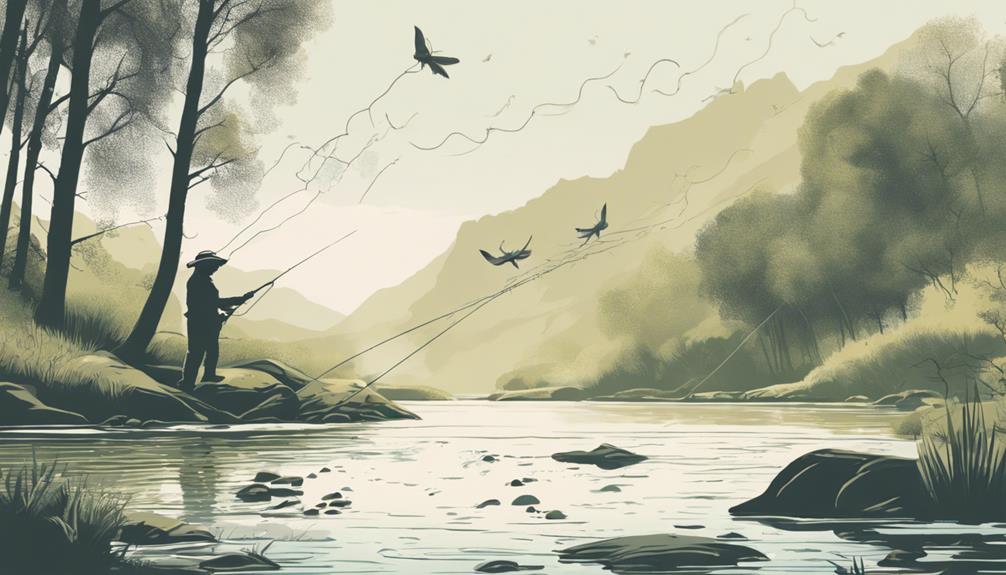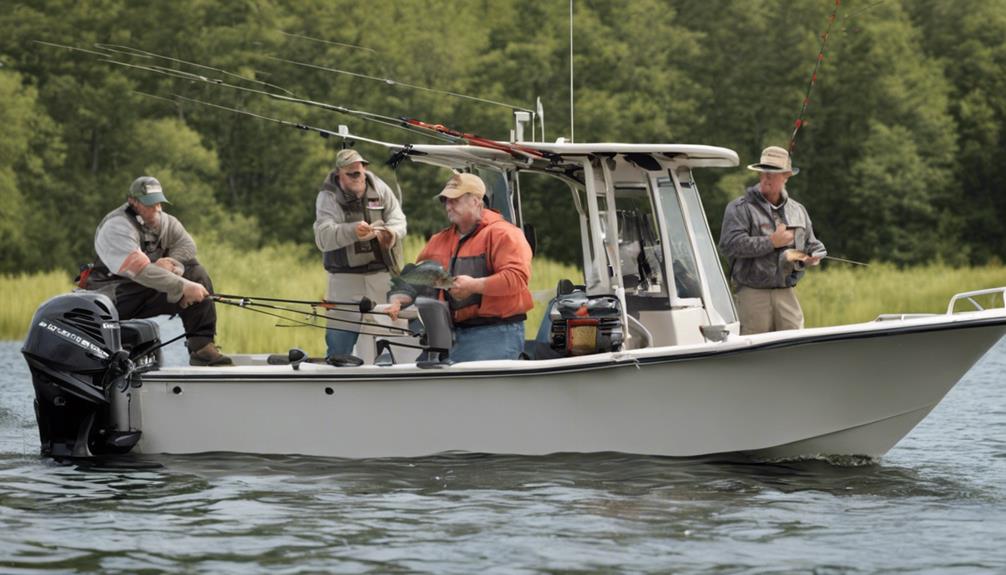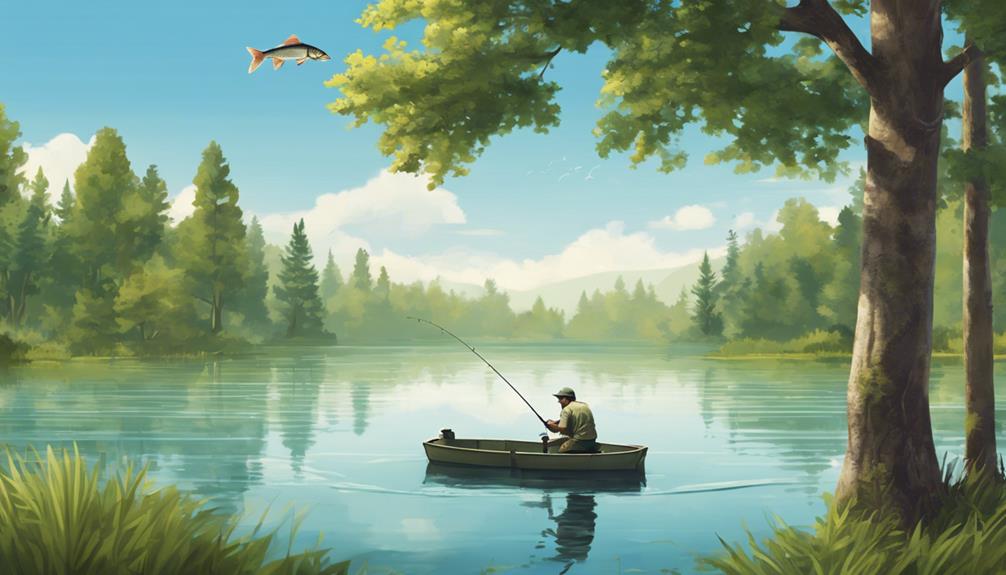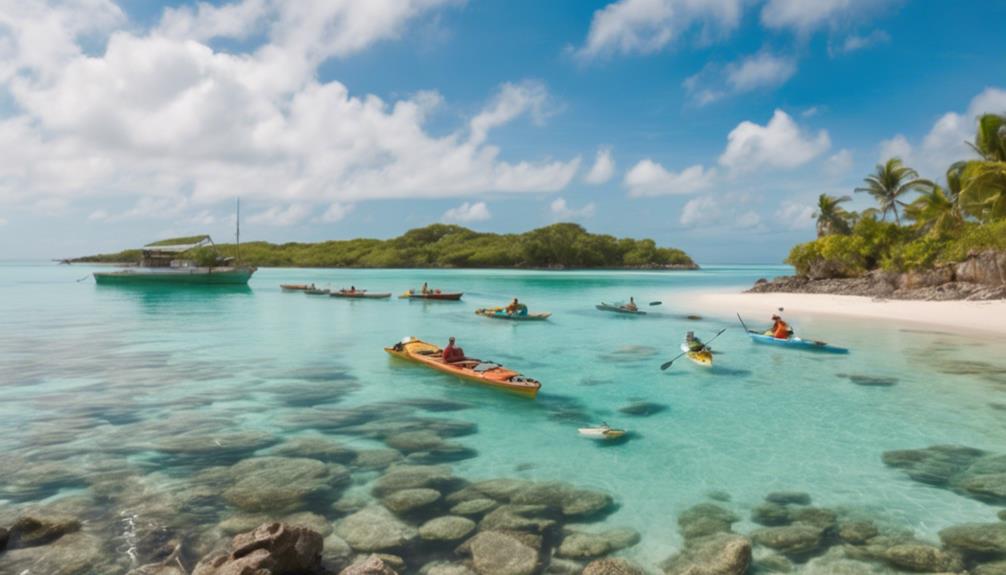You might think that angling is just a harmless pastime, but have you considered the broader impact it has on ecosystems?
From fish populations to habitat disturbance, the repercussions of angling activities are far-reaching.
Understanding how angling practices can influence the delicate balance of our natural environments is crucial for making informed decisions.
Stay tuned to discover the intricate web of effects that angling can have on ecosystems and why it's essential to address these impacts for the well-being of our planet.
Angling's Effect on Fish Populations
Angling impacts fish populations by altering their reproductive dynamics and overall numbers through selective harvesting practices. Stocking programs play a crucial role in maintaining fish populations in angling areas. These programs involve the release of fish into natural water bodies to supplement existing populations. However, the effectiveness of stocking programs can be affected by angling activities. High catch limits can lead to overexploitation of stocked fish, disrupting population dynamics and reducing overall numbers.
Catch limits are put in place to regulate the number and size of fish that can be caught by anglers. When catch limits are exceeded, it can have detrimental effects on fish populations. Overfishing can lead to a decrease in reproductive rates as larger, more fertile fish are removed from the breeding pool. This reduction in reproductive success can further impact population dynamics, potentially leading to declines in overall fish numbers.
Reproductive rates are essential for maintaining healthy fish populations. Angling can influence these rates by selectively targeting larger, more mature fish that are crucial for successful breeding. By removing these individuals from the population, angling can disrupt the natural balance of reproductive dynamics, affecting the long-term sustainability of fish populations in angling areas. It's important for anglers to adhere to catch limits and practice responsible harvesting to ensure the preservation of fish populations for future generations.
Habitat Disturbance From Angling Activities
Habitat disturbance caused by angling activities can have significant impacts on aquatic ecosystems. When anglers frequent a particular area, their presence and actions can lead to various forms of habitat disruption.
- Stream Bank Erosion: The constant movement along stream banks by anglers can contribute to erosion, destabilizing the soil and impacting the overall health of the water body.
- Vegetation Loss: Anglers may inadvertently trample on aquatic vegetation important for the ecosystem, leading to the loss of crucial habitats for fish and other aquatic organisms.
- Disturbance to Aquatic Life: The noise and movement created by angling activities can disturb fish and other aquatic life, affecting their behavior, feeding patterns, and overall well-being.
- Sedimentation Buildup: Activities such as wading and casting can stir up sediment from the bottom of water bodies, leading to increased turbidity and sedimentation buildup, which can have detrimental effects on aquatic ecosystems.
Being mindful of where and how you fish can help minimize the disturbance caused to habitats. Consider rotating fishing spots to reduce the impact on a single area, being cautious around vegetation, and practicing catch-and-release fishing to lessen the overall disruption to aquatic life.
Impacts of Bait and Lure Usage
When using bait and lures while fishing, you should be mindful of their potential impacts on the environment. Lure design plays a crucial role in the environmental impact of angling. Some lures are designed to mimic natural prey, increasing their effectiveness at catching fish. However, certain designs may incorporate materials that can harm marine life if lost or discarded in the water. It's important to choose lures made from environmentally friendly materials and consider the potential consequences of losing them during your fishing activities.
Bait sourcing is another aspect to consider when examining the impacts of bait and lure usage. The sustainability of bait sources is vital to ensure the continued health of ecosystems. Overharvesting baitfish can disrupt the food chain and lead to imbalances in aquatic environments. By supporting sustainable bait sourcing practices, such as using artificial baits or opting for locally sourced bait from responsible suppliers, you can help minimize the negative impact of angling on marine ecosystems.
Efforts are being made within the angling community to promote eco-friendly lure designs and sustainable bait practices. By staying informed and making conscientious choices when selecting bait and lures, you can contribute to the conservation of aquatic ecosystems while still enjoying the sport of fishing. Remember, every decision you make while angling can have a lasting impact on the environment, so choose wisely.
Release Practices and Fish Survival
Consider implementing proper catch-and-release techniques to enhance fish survival rates after angling activities. Fish handling plays a crucial role in determining the survival of the fish post-release. Minimize stress and mortality by following these key practices:
- Use barbless hooks: Barbless hooks are easier to remove, reducing the handling time and potential injury to the fish.
- Minimize air exposure: Keep the fish in the water as much as possible to prevent issues like air embolism, which can be fatal.
- Handle with wet hands: Wet hands help protect the fish's slime coat, which is essential for their health and survival.
- Avoid damaging vital organs: Be gentle when removing the hook to prevent harm to the fish's mouth and other critical areas.
Improper handling can lead to increased stress levels in fish, making them more susceptible to post-release mortality. By adhering to these catch-and-release best practices, you can help ensure that the fish you release have the best chance of survival. Remember, the goal is to enjoy angling while also preserving the health and well-being of the ecosystem.
Water Quality Concerns
To ensure the overall health of the ecosystem, understanding and addressing water quality concerns is paramount in sustaining the balance of aquatic environments. Pollution prevention plays a crucial role in safeguarding the quality of water bodies where angling activities take place. By adopting responsible practices such as proper waste disposal and minimizing the use of harmful chemicals, anglers can significantly contribute to maintaining pristine water conditions.
Pollutants like chemicals, excess nutrients, and litter can have detrimental effects on aquatic life, endangering the delicate balance of the ecosystem. It's essential to prioritize aquatic life protection by being mindful of the impact angling activities can have on water quality. Taking steps to reduce pollution not only benefits the fish populations but also ensures the overall health of the entire aquatic environment.
Regular monitoring of water quality parameters is another effective way to detect any potential issues early on and take corrective actions promptly. By staying informed about the quality of the water in which you engage in angling, you can play a proactive role in preserving the ecosystem. Remember, every action you take towards pollution prevention and aquatic life protection contributes to the sustainability of the aquatic environment for future generations to enjoy.
Invasive Species Spread Through Angling
Anglers inadvertently contribute to the spread of invasive species through their fishing activities, posing a significant threat to native ecosystems. When moving from one water body to another, your equipment can inadvertently carry invasive species, disrupting the delicate balance of the environment. To prevent this, it's crucial to implement biosecurity measures before and after your fishing trips.
Invasive Species Spread Through Angling:
- Inspect and Clean: Before leaving a fishing spot, take the time to thoroughly inspect and clean your gear, including boats, fishing rods, and nets, to remove any potential invasive species.
- Dispose Properly: Dispose of any unused bait properly and never release live bait into the water, as it could introduce invasive species to new habitats.
- Educate Yourself: Learn to identify invasive species common in the areas you fish and report any sightings to local authorities for control measures.
- Support Regulations: Follow regulations that help prevent the spread of invasive species, such as restrictions on moving fish between water bodies.
Balancing Recreation With Conservation
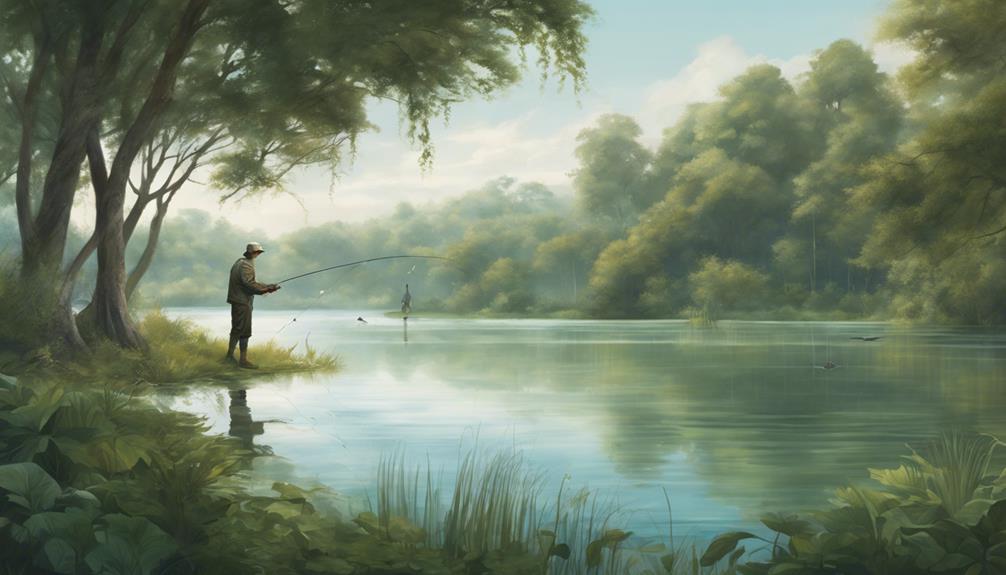
In your pursuit of angling adventures, it's paramount to strike a harmonious balance between recreation and conservation efforts to ensure the long-term sustainability of ecosystems. Conservation ethics should underpin every fishing trip, guiding your actions to minimize negative impacts on the environment. As an angler, you play a crucial role in maintaining the delicate equilibrium of aquatic ecosystems.
To achieve this balance, it's essential to prioritize the principles of conservation ethics. Respect the natural habitats of the fish you seek to catch, leaving no trace of your presence behind. Practice catch and release techniques, handle fish with care, and use barbless hooks to minimize harm. By embracing these ethical guidelines, you contribute to the preservation of fish populations and their habitats for future generations to enjoy.
Furthermore, maintaining recreational balance is key. Limit your catch to sustainable levels, adhering to local regulations and size limits. Avoid overfishing popular spots and consider exploring new areas to distribute fishing pressure more evenly. By spreading out angling activities, you reduce the strain on specific ecosystems, allowing them to recover and thrive.
Collaborative Efforts for Sustainable Angling
Collaborating with local conservation organizations enhances the sustainability of angling practices and fosters a healthier ecosystem for future generations. By joining forces with these groups, you can make a significant impact on the environment while still enjoying your favorite pastime. Here are some key ways in which collaborative efforts can promote sustainable angling:
- Conservation Partnerships: Partnering with conservation organizations allows you to contribute directly to efforts aimed at protecting fish populations and their habitats.
- Responsible Fishing: Through collaboration, you can learn about and implement responsible fishing practices that help maintain healthy fish stocks for the future.
- Community Engagement: Engaging with local communities through these partnerships raises awareness about the importance of sustainable angling and encourages others to follow suit.
- Marine Stewardship: By working together with these organizations, you can actively participate in marine stewardship initiatives that focus on the long-term health of marine ecosystems.
Through active engagement and collaboration with conservation groups, you can play a crucial role in ensuring that angling remains sustainable for years to come. By embracing responsible fishing practices and promoting marine stewardship, you contribute to the preservation of our precious ecosystems and the conservation of marine life.
Frequently Asked Questions
How Do Different Types of Bait and Lures Used in Angling Affect Fish Behavior and Population Dynamics?
When you choose bait and lures for angling, you impact fish behavior and population dynamics. Different types of bait can either attract or repel certain fish species, influencing their feeding habits and movement patterns. The right bait can lead to more catches, while inappropriate choices may harm fish populations.
Are There Specific Regulations in Place to Minimize Habitat Disturbance Caused by Angling Activities?
To minimize habitat disturbance caused by angling activities, conservation regulations are in place. These rules aim to protect habitats and preserve ecosystems.
As an angler, it's your responsibility to follow these regulations to ensure the sustainability of fish populations and their environments. By respecting these guidelines, you contribute to the long-term health of aquatic ecosystems and help maintain a balance between angling enjoyment and habitat conservation.
What Are Some Common Practices for Releasing Fish Back Into the Water to Ensure Their Survival?
When you're practicing catch and release, it's crucial to handle the fish properly. Use wet hands to minimize damage to their protective slime layer. Support their body, especially the belly, to avoid internal injuries. Minimize air exposure and handling time.
Ensure the fish is lively before release. Allow it to swim away on its own. Following these handling techniques boosts fish survival rates and ensures they receive the post-release care needed for a successful return to their habitat.
How Does Angling Impact the Overall Water Quality of Ecosystems, and What Measures Are Taken to Mitigate Any Negative Effects?
When you fish, water pollution can be a concern due to bait residues and potential spills from boats. Some angling techniques, like using biodegradable bait and proper waste disposal, can help reduce these impacts.
To safeguard ecosystem health, conservation efforts such as catch-and-release practices, habitat restoration, and promoting sustainable fishing limits are vital. These measures aim to minimize negative effects on water quality and preserve aquatic environments for future generations.
Can Angling Contribute to the Spread of Invasive Species, and What Steps Are Being Taken to Prevent This From Happening?
When you go angling, you might unknowingly contribute to the spread of invasive species. Biosecurity measures and education programs are essential to prevent this.
Monitoring efforts help track the potential introduction of invasive species. Stay informed, follow guidelines, and be mindful of your equipment and surroundings.
Conclusion
Overall, angling has both positive and negative impacts on ecosystems. While it can help manage fish populations and promote conservation efforts, it also poses threats such as habitat disturbance, water quality concerns, and the spread of invasive species.
It's important for anglers to practice sustainable fishing techniques, release practices, and work collaboratively with conservation organizations to ensure the long-term health and balance of aquatic ecosystems. By being mindful of these impacts, anglers can enjoy their sport while protecting the environment.
